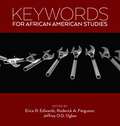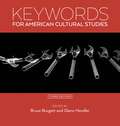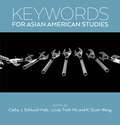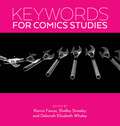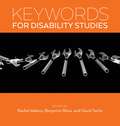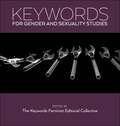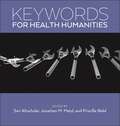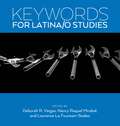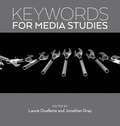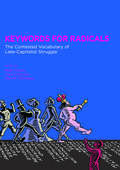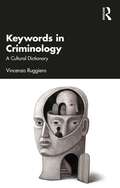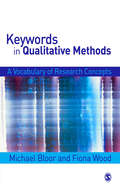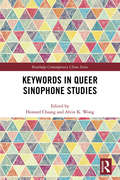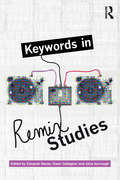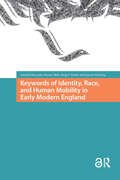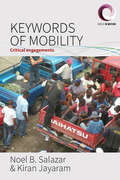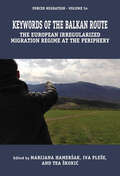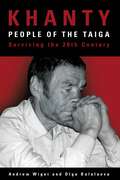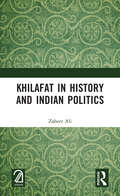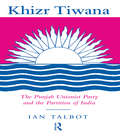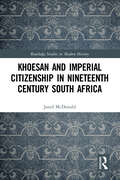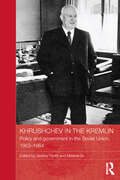- Table View
- List View
Keywords for African American Studies (Keywords #8)
by Roderick A. Ferguson Jeffrey O.G. OgbarIntroduces key terms, interdisciplinary research, debates, and histories for African American StudiesAs the longest-standing interdisciplinary field, African American Studies has laid the foundation for critically analyzing issues of race, ethnicity, and culture within the academy and beyond. This volume assembles the keywords of this field for the first time, exploring not only the history of those categories but their continued relevance in the contemporary moment. Taking up a vast array of issues such as slavery, colonialism, prison expansion, sexuality, gender, feminism, war, and popular culture, Keywords for African American Studies showcases the startling breadth that characterizes the field.Featuring an august group of contributors across the social sciences and the humanities, the keywords assembled within the pages of this volume exemplify the depth and range of scholarly inquiry into Black life in the United States. Connecting lineages of Black knowledge production to contemporary considerations of race, gender, class, and sexuality, Keywords for African American Studies provides a model for how the scholarship of the field can meet the challenges of our social world.
Keywords for American Cultural Studies, Third Edition (Keywords #11)
by Walter Johnson Andrew Ross Lisa Nakamura Angela D. Dillard George Lipsitz Sunaina Maira Nikhil Pal Singh E. Patrick Johnson Timothy Mitchell Carla L. Peterson George J. Sanchez Ashley Dawson Josh Kun Caleb Smith Kandice Chuh Lisa Lowe Ann Cvetkovich Christopher Newfield George Yúdice Alys Eve Weinbaum Brian T. Edwards Leerom Medovoi Lauren Berlant Junaid Rana Erin Manning Cynthia G. Franklin Julie Sze Scott Herring Christina B. Hanhardt Rebecca Wanzo Juana María Rodríguez Marc Bousquet Laura Briggs Sandra M. Gustafson Erica Kohl-Arenas Kevin K. Gaines Henry Yu David Kazanjian Dean Spade Siobhan B. Somerville Crystal Parikh Lee Bebout Rebecca Hill Jack Halberstam Kirsten Silva Gruesz Eric Lott David F. Ruccio Marlene L. Daut Kyla Schuller Jentery Sayers Robert McRuer Matthew Frye Jacobson Alyshia Gálvez Kembrew McLeod Daniel Martinez HoSang Valerie Rohy Joseph Lowndes Amaranth Borsuk Robert Fanuzzi John Kuo Wei Tchen Lauren Klein Miriam Posner Tara McPherson Jodi Melamed Vermonja R. Alston Stephanie Smallwood J. Kēhaulani Kauanui June Wayee Chau Oneka LaBennett Tavia Nyong’oIntroduces key terms, research traditions, debates, and histories for American Studies and Cultural Studies in an updated editionSince its initial publication, scholars and students alike have turned to Keywords for American Cultural Studies as an invaluable resource for understanding key terms and debates in the fields of American studies and cultural studies. As scholarship has continued to evolve, this revised and expanded third edition offers indispensable meditations on new and developing concepts used in American studies, cultural studies, and beyond.Designed as a uniquely print-digital hybrid publication, this Keywords volume collects 114 essays, each focused on a single term such as “America,” “culture,” “diversity,” or “religion.” More than forty of the essays have been significantly revised for this new edition, and there are nineteen completely new keywords, including crucial additions such as “biopolitics,” “data,” “debt,” and “intersectionality.” Throughout the volume, interdisciplinary scholars explore these terms and others as nodal points in many of today’s most dynamic and vexed discussions of political and social life, both inside and outside of the academy. The Keywords website features forty-eight essays not in the print volume; it also provides pedagogical tools for instructors using print and online keywords in their courses.The publication brings together essays by interdisciplinary scholars working in literary studies and political economy, cultural anthropology and ethnic studies, African American history and performance studies, gender studies and political theory. Some entries are explicitly argumentative; others are more descriptive. All are clear, challenging, and critically engaged. As a whole, Keywords for American Cultural Studies provides an accessible A-to-Z survey of prevailing academic buzzwords and a flexible tool for carving out new areas of inquiry.
Keywords for Asian American Studies (Keywords #4)
by K. Scott WongIntroduces key terms, research frameworks, debates, and histories for Asian American StudiesBorn out of the Civil Rights and Third World Liberation movements of the 1960s and 1970s, Asian American Studies has grown significantly over the past four decades, both as a distinct field of inquiry and as a potent site of critique. Characterized by transnational, trans-Pacific, and trans-hemispheric considerations of race, ethnicity, migration, immigration, gender, sexuality, and class, this multidisciplinary field engages with a set of concepts profoundly shaped by past and present histories of racialization and social formation. The keywords included in this collection are central to social sciences, humanities, and cultural studies and reflect the ways in which Asian American Studies has transformed scholarly discourses, research agendas, and pedagogical frameworks. Spanning multiple histories, numerous migrations, and diverse populations, Keywords for Asian American Studies reconsiders and recalibrates the ever-shifting borders of Asian American studies as a distinctly interdisciplinary field. Visit keywords.nyupress.org for online essays, teaching resources, and more.
Keywords for Comics Studies (Keywords)
by Andrew Hoberek Shelley Streeby Jared Gardner Scott Bukatman Darieck Scott Nicholas Sammond Mimi Thi Nguyen Cathy Schlund-Vials Frederick Luis Aldama Bart Beaty Rebecca Wanzo Blair Davis Tahneer Oksman Michael Chaney Jonathan W. Gray Benjamin Woo Ian Gordon Stacey Robinson Frank Bramlett Adam L. Kern Yetta Howard Brannon Costello Charles Hatfield José Alaniz Gregory Steirer Aaron Kashtan Deborah Elizabeth Whaley Alexandro Segade Amy Kiste Nyberg André Carrington Anthony Michael D’Agostino Barbara Postema Benjamin Saunders Carol L. Tilley Christopher Pizzino Christopher Spaide Cáel M. Keegan Ellen Kirkpatrick Enrique García Ian Blechschmidt Isabel Millán Jessica Quick Stark Joo Ok Kim Joshua Abraham Kopin Justin Hall Leah Misemer Margaret Galvan Matt Silady Michael Mark Cohen Nicholas Yanes Osvaldo Oyola Phil Jimenez Sara Biggs Chaney Sean Guynes Susan KirtleyIntroduces key terms, research traditions, debates, and histories, and offers a sense of the new frontiers emerging in the field of comics studiesAcross more than fifty original essays, Keywords for Comics Studies provides a rich, interdisciplinary vocabulary for comics and sequential art. The essays also identify new avenues of research into one of the most popular and diverse visual media of the twentieth and twenty-first centuries.Keywords for Comics Studies presents an array of inventive analyses of terms central to the study of comics and sequential art that are traditionally siloed in distinct lexicons: these include creative and aesthetic terms like Ink, Creator, Border, and Panel; conceptual terms such as Trans*, Disability, Universe, and Fantasy; genre terms like Zine, Pornography, Superhero, and Manga; and canonical terms like X-Men, Archie, Watchmen, and Love and Rockets.This volume ties each specific comic studies keyword to the larger context of the term within the humanities. Essays demonstrate how scholars, cultural critics, and comics artists from a range of fields take up sequential art as both an object of analysis and a medium for developing new theories about embodiment, identity, literacy, audience reception, genre, cultural politics, and more. Keywords for Comics Studies revivifies the fantasy and magic of reading comics in its kaleidoscopic view of the field’s most compelling and imaginative ideas.
Keywords for Disability Studies (Keywords #7)
by Rachel Adams David Serlin Benjamin ReissIntroduces key terms, concepts, debates, and histories for Disability StudiesKeywords for Disability Studies aims to broaden and define the conceptual framework of disability studies for readers and practitioners in the field and beyond. The volume engages some of the most pressing debates of our time, such as prenatal testing, euthanasia, accessibility in public transportation and the workplace, post-traumatic stress, and questions about the beginning and end of life.Each of the 60 essays in Keywords for Disability Studies focuses on a distinct critical concept, including “ethics,” “medicalization,” “performance,” “reproduction,” “identity,” and “stigma,” among others. Although the essays recognize that “disability” is often used as an umbrella term, the contributors to the volume avoid treating individual disabilities as keywords, and instead interrogate concepts that encompass different components of the social and bodily experience of disability. The essays approach disability as an embodied condition, a mutable historical phenomenon, and a social, political, and cultural identity.An invaluable resource for students and scholars alike, Keywords for Disability Studies brings the debates that have often remained internal to disability studies into a wider field of critical discourse, providing opportunities for fresh theoretical considerations of the field’s core presuppositions through a variety of disciplinary perspectives.Visit keywords.nyupress.org for online essays, teaching resources, and more.
Keywords for Gender and Sexuality Studies (Keywords #13)
by Mishuana Goeman Aimee Bahng Kyla Wazana Tompkins Amber Jamilla Musser Aren Z. Aizura Karma R. ChávezIntroduces key terms, debates, and histories for feminist studies in gender and sexualityKeywords for Gender and Sexuality Studies introduces readers to a set of terms that will aid them in understanding the central methodological and political stakes currently energizing feminist and queer studies. The volume deepens the analyses of this field by highlighting justice-oriented intersectional movements and foregrounding Black, Indigenous, and women of color feminisms; transnational feminisms; queer of color critique; trans, disability, and fat studies; feminist science studies; and critiques of the state, law, and prisons that emerge from queer and women of color justice movements. Many of the keywords featured in this publication call attention to the fundamental assumptions of humanism’s political and intellectual debates—from the racialized contours of property and ownership to eugenicist discourses of improvement and development. Interventions to these frameworks arise out of queer, feminist and anti-racist engagements with matter and ecology as well as efforts to imagine forms of relationality beyond settler colonial and imperialist epistemologiesReflecting the interdisciplinary breadth of the field, this collection of seventy essays by scholars across the social sciences and the humanities weaves together methodologies from science and technology studies, affect theory, and queer historiographies, as well as Black Studies, Latinx Studies, Asian American, and Indigenous Studies. Taken together, these essays move alongside the distinct histories and myriad solidarities of the fields to construct the much awaited Keywords for Gender and Sexuality Studies.
Keywords for Health Humanities (Keywords)
by Priscilla Wald Jonathan M. Metzl Sari AltschulerIntroduces key concepts and debates in health humanities and the health professions.Keywords for Health Humanities provides a rich, interdisciplinary vocabulary for the burgeoning field of health humanities and, more broadly, for the study of medicine and health. Sixty-five entries by leading international scholars examine current practices, ideas, histories, and debates around health and illness, revealing the social, cultural, and political factors that structure health conditions and shape health outcomes.Presenting possibilities for health justice and social change, this volume exposes readers—from curious beginners to cultural analysts, from medical students to health care practitioners of all fields—to lively debates about the complexities of health and illness and their ethical and political implications. A study of the vocabulary that comprises and shapes a broad understanding of health and the practices of healthcare, Keywords for Health Humanities guides readers toward ways to communicate accurately and effectively while engaging in creative analytical thinking about health and healthcare in an increasingly complex world—one in which seemingly straightforward beliefs and decisions about individual and communal health represent increasingly contested terrain.The online essays for all Keywords titles can be found here: keywords.nyupress.org
Keywords for Latina/o Studies (Keywords #6)
by Nancy Raquel Mirabal Lawrence La Fountain-Stokes Deborah R Vargas2018 Outstanding Academic Title, given by CHOICE MagazineIntroduces key terms, concepts, debates, and histories for Latinx StudiesKeywords for Latina/o Studies is a generative text that enhances the ongoing dialogue within a rapidly growing and changing field. The keywords included in this collection represent established and emergent terms, categories, and concepts that undergird Latina/o studies; they delineate the shifting contours of a field best thought of as an intellectual imaginary and experiential project of social and cultural identities within the US academy. Bringing together 63 essays, from humanists, historians, anthropologists, sociologists, among others, each focused on a single term, the volume reveals the broad range of the field while also illuminating the tensions and contestations surrounding issues of language, politics, and histories of colonization, specific to this area of study. From “borderlands” to “migration,” from “citizenship” to “mestizaje,” this accessible volume will be informative for those who are new to Latina/o studies, providing them with a mapping of the current debates and a trajectory of the development of the field, as well as being a valuable resource for scholars to expand their knowledge and critical engagement with the dynamic transformations in the field.
Keywords for Media Studies (Keywords #5)
by Jonathan Gray Laurie OuelletteIntroduces key terms, research traditions, debates, and their histories, and offers a sense of the new frontiers and questions emerging in the field of media studies Keywords for Media Studies introduces and aims to advance the field of critical media studies by tracing, defining, and problematizing its established and emergent terminology. The book historicizes thinking about media and society, whether that means noting a long history of “new media,” or tracing how understandings of media “power” vary across time periods and knowledge formations. Bringing together an impressive group of established scholars from television studies, film studies, sound studies, games studies, and more, each of the 65 essays in the volume focuses on a critical concept, from “fan” to “industry,” and “celebrity” to “surveillance.” Keywords for Media Studies is an essential tool that introduces key terms, research traditions, debates, and their histories, and offers a sense of the new frontiers and questions emerging in the field of media studies. Visit keywords.nyupress.org for online essays, teaching resources, and more.
Keywords for Radicals: The Contested Vocabulary of Late-Capitalist Struggle
by A. K. Thompson Joy James Kelly Fritsch Clare O'Connor Silvia Federici"An extraordinary volume that provides nothing less than a detailed cognitive mapping of the terrain for everyone who wants to engage in radical politics. "—Slavoj Žižek, author of Living in the End Times "From its thought-provoking Introduction though its energizing accounts of the tensions underlying our most prized concepts, Keywords for Radicals will be indispensable to any scholar or activist who is serious about critique and change. "—Stephen Duncombe, editor of Cultural Resistance Reader In Keywords (1976), Raymond Williams devised a "vocabulary" that reflected the vast social transformations of the post-war period. He revealed how these transformations could be grasped by investigating changes in word usage and meaning. Keywords for Radicals—part homage, part development—asks: What vocabulary might illuminate the social transformations marking our own contested present? How do these words define the imaginary of today's radical left? With insights from dozens of scholars and troublemakers, Keywords for Radicals explores the words that shape our political landscape. Each entry highlights a term's contested variations, traces its evolving usage, and speculates about what its historical mutations can tell us. More than a glossary, this is a crucial study of the power of language and the social contradictions hidden within it. Contributors include Patrick Bond, Silvia Federici, John Bellamy Foster, Joy James, Ilan Pappé, Justin Podur, Nina Power, Mab Segrest, and more. Kelly Fritsch is a Banting Postdoctoral Fellow in Women's and Gender Studies at the University of Toronto. Clare O'Connor is a doctoral student in Communication at the University of Southern California. A. K. Thompson teaches social theory at Fordham University in New York.
Keywords in Criminology: A Cultural Dictionary
by Vincenzo RuggieroTaking inspiration from the classic text by Raymond Williams, Keywords in Criminology reflects on the language used by criminologists and offers a one‑stop guide to core concepts in the discipline. Written for the budding Criminology student, it offers a specialized but plain dictionary for a specialized discipline.From Abolitionism to Xenophobia, the entries unveil the ambiguities and conflicting interpretations of the concepts discussed, and explore their historical context, their analytical use, adoption or critical rejection. The original formulation of each concept is examined along with the practices the concept has shaped, and the favourable and unfavourable outcomes it has generated. Keywords in Criminology is a handy and pithy companion for any Criminology student. It offers excellent supplementary reading for core courses on criminological, social and cultural theory.
Keywords in Qualitative Methods: A Vocabulary of Research Concepts
by Fiona Wood Michael BloorAn essential companion for students across the social and health sciences, this text provides a wide-ranging coverage of qualitative methods complemented by extended illustration from the array of academic disciplines in which qualitative research is found and employed. Written in a lively and reader-friendly style, the guide covers a comprehensive range of topics, including: - a concise definition of the method - a description of distinctive features - examples to convey the flavour of a technique or principle - a critical and reflective evaluation of the method or approach under consideration - cross references to associated concepts within the dictionary - a list of key readings
Keywords in Queer Sinophone Studies (Routledge Contemporary China Series)
by Howard Chiang Alvin K. WongThis volume showcases a vibrant wave of scholarship that explores the intersection of queer theory and Sinophone studies, consolidating an interdisciplinary framework for furthering transnational research into non-conforming genders, sexualities and bodies. Engaging with contemporary debates and controversies, Keywords in Queer Sinophone Studies presents a definitive collection of original contributions, which are both theoretically and empirically grounded and cross-disciplinary in nature. Individual chapters offer an in-depth study of new empirical data and case studies, covering keywords such as transpacific, viscerality, fandom, postcoloniality, ethnicity and activism. Imagining new conversations across several fields, including literature, film, communication, ethnic studies, anthropology, history, sociology and politics, this book will appeal to students and scholars of Queer Studies and Asian culture, literature and film, as well as gender and sexuality.
Keywords in Remix Studies
by Xtine Burrough Eduardo Navas Owen GallagherKeywords in Remix Studies consists of twenty-four chapters authored by researchers who share interests in remix studies and remix culture throughout the arts and humanities. The essays reflect on the critical, historical and theoretical lineage of remix to the technological production that makes contemporary forms of communication and creativity possible. Remix enjoys international attention as it continues to become a paradigm of reference across many disciplines, due in part to its interdisciplinary nature as an unexpectedly fragmented approach and method useful in various fields to expand specific research interests. The focus on a specific keyword for each essay enables contributors to expose culture and society’s inconclusive relation with the creative process, and questions assumptions about authorship, plagiarism and originality. Keywords in Remix Studies is a resource for scholars, including researchers, practitioners, lecturers and students, interested in some or all aspects of remix studies. It can be a reference manual and introductory resource, as well as a teaching tool across the humanities and social sciences.
Keywords in Sound
by David Novak Matt SakakeenyIn twenty essays on subjects such as noise, acoustics, music, and silence, Keywords in Sound presents a definitive resource for sound studies, and a compelling argument for why studying sound matters. Each contributor details their keyword's intellectual history, outlines its role in cultural, social and political discourses, and suggests possibilities for further research. Keywords in Sound charts the philosophical debates and core problems in defining, classifying and conceptualizing sound, and sets new challenges for the development of sound studies. Contributors. Andrew Eisenberg, Veit Erlmann, Patrick Feaster, Steven Feld, Daniel Fisher, Stefan Helmreich, Charles Hirschkind, Deborah Kapchan, Mara Mills, John Mowitt, David Novak, Ana Maria Ochoa Gautier, Thomas Porcello, Tom Rice, Tara Rodgers, Matt Sakakeeny, David Samuels, Mark M. Smith, Benjamin Steege, Jonathan Sterne, Amanda Weidman
Keywords of Identity, Race, and Human Mobility in Early Modern England (Connected Histories in the Early Modern World)
by Nandini Das Lauren Working João Vicente Melo Haig SmithWhat did it mean to be a stranger in sixteenth- and seventeenth-century England? How were other nations, cultures, and religions perceived? What happened when individuals moved between languages, countries, religions, and spaces? Keywords of Identity, Race, and Human Mobility analyses a selection of terms that were central to the conceptualisation of identity, race, migration, and transculturality in the early modern period. In many cases, the concepts and debates that they embody – or sometimes subsume – came to play crucial roles in the articulation of identity, rights, and power in subsequent periods. Together, the essays in this volume provide an invaluable resource for anyone interested in the development of these formative issues.
Keywords of Mobility: Critical Engagements
by Kiran Jayaram Noel B. SalazarScholars from various disciplines have used key concepts to grasp mobilities, but as of yet, a working vocabulary of these has not been fully developed. Given this context and inspired in part by Raymond Williams' Keywords (1976), this edited volume presents contributions that critically analyze mobility-related keywords: capital, cosmopolitanism, freedom, gender, immobility, infrastructure, motility, and regime. Each chapter provides an historical context, a critical analysis of how the keyword has been used in relation to mobility, and a conclusion that proposes future usage or research.
Keywords of the Balkan Route: The European Irregularized Migration Regime at the Periphery (Forced Migration)
by Marijana Hameršak Iva Pleše Tea ŠkokićShaped by the criminalization of migration and control over movement, the Balkan Route has emerged as a key site of border violence and migrant resistance along the southeastern edges of the European Union. Keywords of the Balkan Route explores the vocabularies structuring this regime by tracing the meanings, overlaps, and tensions of terms such as Autonomy, Route, Waiting, Game, and Solidarity. Featuring contributors from Croatia, Slovenia, and Serbia, the volume draws on ethnographic research and interdisciplinary approaches to examine restricted mobilities and border struggles through critically engaged perspectives and experimental analytical formats.
Khanty, People of the Taiga: Surviving the 20th Century
by Andrew Wiget Olga BalalaevaDrawing on nearly twenty years of fieldwork, as well as ethnohistory, politics, and economics, this volume takes a close look at changes in the lives of the indigenous Siberian Khanty people and draws crucial connections between those changes and the social, cultural, and political transformation that swept Russia during the transition to democracy. Delving deeply into the history of the Khanty—who were almost completely isolated prior to the Russian revolution—the authors show how the customs, traditions, and knowledge of indigenous people interact with and are threatened by events in the larger world.
Khilafat in History and Indian Politics
by Zaheer AliThis book is a brief historical account of Khilafat, an Islamic political institution mired in controversies from its inception. It is an attempt to present an objective critique of the Islamic polity that, in a way, was primarily responsible for crafting schisms in Islam with its commencement. By the time the last Khilafat of the Ottomans came to an end in the aftershock of the Second World War, the Muslim political elite in India launched a movement for the restoration and continuation of the Ottoman Khilafat. The most paradoxical dimension of the issue was that in the Arab peninsula, the epicenter of Islam, the people were struggling to cast away the yoke of the Ottoman Khilafat, then why were the Indian Muslims emotionally involved in a movement that was vehemently condemned and assailed by a majority of Muslims outside the Indian subcontinent? This title is co-published with Aakar Books. Print editions not for sale in South Asia (India, Sri Lanka, Nepal, Bangladesh, Pakistan and Bhutan)
Khizr Tiwana, the Punjab Unionist Party and the Partition of India: The Punjab Unionist Party And The Partition Of India
by Ian TalbotFirst biography of Khizr Tiwana, the Unionist Premier of the Punjab during the climacteric period 1942-47. The Punjab formed the heartland of a future Pakistan, hence the subcontinent's destiny rested on the clash between Khizr and Jinnah over the region's unity vs Muslim separatism.
Khoesan and Imperial Citizenship in Nineteenth Century South Africa (Routledge Studies in Modern History)
by Jared McDonaldThis volume explores the formative and expressive dynamics of Khoesan identity during a crucial period of incorporation as an underclass into Cape colonial society. Khoesan and Imperial Citizenship in Nineteenth Century South Africa emphasises loyalism and subjecthood – posited as imperial citizenship – as foundational aspects of Khoesan resistance to the debilitating effects of settler colonialism. The work argues that Khoesan were active in the creation of their identity as imperial citizens and that expressions of loyalty to the British Crown were reflective of a political and civic consciousness that transcended their racially defined place in Cape colonial society. Following a chronological trajectory from the mid-1790s to the late 1850s, author Jared McDonald examines the combined influences of colonial law, evangelical-humanitarianism, imperial commissions of inquiry, and the abolition of slavery as conduits for the notion of imperial citizenship. As histories and legacies of colonialism come under increasing scrutiny, the history of the Khoesan during this period highlights the complex nature of power and its imposition, and the myriad, nuanced ways in which the oppressed react, resist, and engage. This book will be of interest to scholars and students working on British imperialism in Africa, as well as histories of settler colonialism, nationalism, and loyalism.
Khoesan and Imperial Citizenship in Nineteenth Century South Africa (Routledge Studies in Modern History)
by Jared McDonaldThis volume explores the formative and expressive dynamics of Khoesan identity during a crucial period of incorporation as an underclass into Cape colonial society.Khoesan and Imperial Citizenship in Nineteenth Century South Africa emphasises loyalism and subjecthood – posited as imperial citizenship – as foundational aspects of Khoesan resistance to the debilitating effects of settler colonialism. The work argues that Khoesan were active in the creation of their identity as imperial citizens and that expressions of loyalty to the British Crown were reflective of a political and civic consciousness that transcended their racially defined place in Cape colonial society. Following a chronological trajectory from the mid-1790s to the late 1850s, author Jared McDonald examines the combined influences of colonial law, evangelical-humanitarianism, imperial commissions of inquiry, and the abolition of slavery as conduits for the notion of imperial citizenship. As histories and legacies of colonialism come under increasing scrutiny, the history of the Khoesan during this period highlights the complex nature of power and its imposition, and the myriad, nuanced ways in which the oppressed react, resist, and engage.This book will be of interest to scholars and students working on British imperialism in Africa, as well as histories of settler colonialism, nationalism, and loyalism.
Khrushchev in the Kremlin: Policy and Government in the Soviet Union, 1953–64 (BASEES/Routledge Series on Russian and East European Studies)
by Jeremy SmithThis book presents a new picture of the politics, economics and process of government in the Soviet Union under the leadership of Nikita Khrushchev. Based in large part on original research in recently declassified archive collections, the book examines the full complexity of government, including formal and informal political relationships; economic reforms and nationality relations in the national republics of the USSR; the treatment of political dissent; economic progress through technological innovation; relations with the Eastern bloc; corruption and deceit in the economy; and the reform of the railways and construction sectors. The book re-evaluates the Khrushchev era as one which represented a significant departure from the Stalin years, introducing a number of policy changes that only came to fruition later, whilst still suffering from many of the limitations imposed by the Stalinist system. Unlike many other studies which consider the subject from the perspective of the Cold War and superpower relations, this book provides an overview of the internal development of the Soviet Union in this period, locating it in the broader context of Soviet history. This is the companion volume to the Jeremy Smith and Melanie Ilic’s previous edited collection, Soviet State and Society under Nikita Khrushchev (Routledge, 2009).
Kick The Dead Lion: A Case Book Of The Custer Battle
by Charles G. Du BoisVol. One in ECHOES OF THE LITTLE BIG HORN SERIES, KICK THE DEAD LION by Charles G. du Bois, is a Custer classic, it focuses on the performance of Custer, Benteen and Reno; Enlisted Men's Petition analysed."On June 25, 1876, the greatest Indian battle in the history of the American West was fought on the Little Bighorn River in southeastern Montana. The combined forces of Sioux and Cheyennes encamped there defeated the Seventh U.S. Cavalry Regiment and annihilated five companies of the regiment under the personal leadership of Brevet Major General George Armstrong Custer.The firing had scarcely ceased, the Indians had only scattered, and the soldier dead still lay hastily buried on a lonely Montana ridge when it began--the unending, ever-increasing slander and defamation against General Custer. His brilliant record established during the Civil War, his victories on the western plains in the years that followed were ignored. The nation's hero was slowly toppled from his pedestal.The Lion was dead.Like jackals snapping at the heels of the lord of the jungle, the defamers began their work. It was no simple task, but they applied themselves with vigor. So thorough was the campaign that only those close to the fallen Custer rallied to his defense. Now they are gone, friend and foe alike, but the perpetrators of the campaign of hate have bequeathed to history a legacy of distorted fact and perverted truth."-Introduction.
